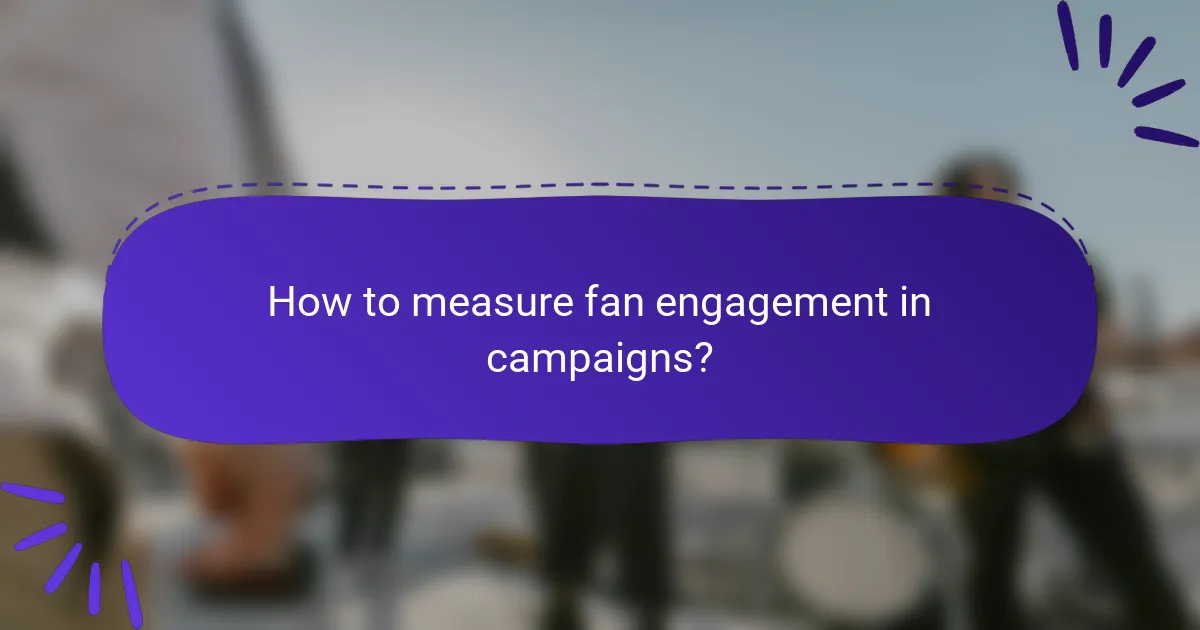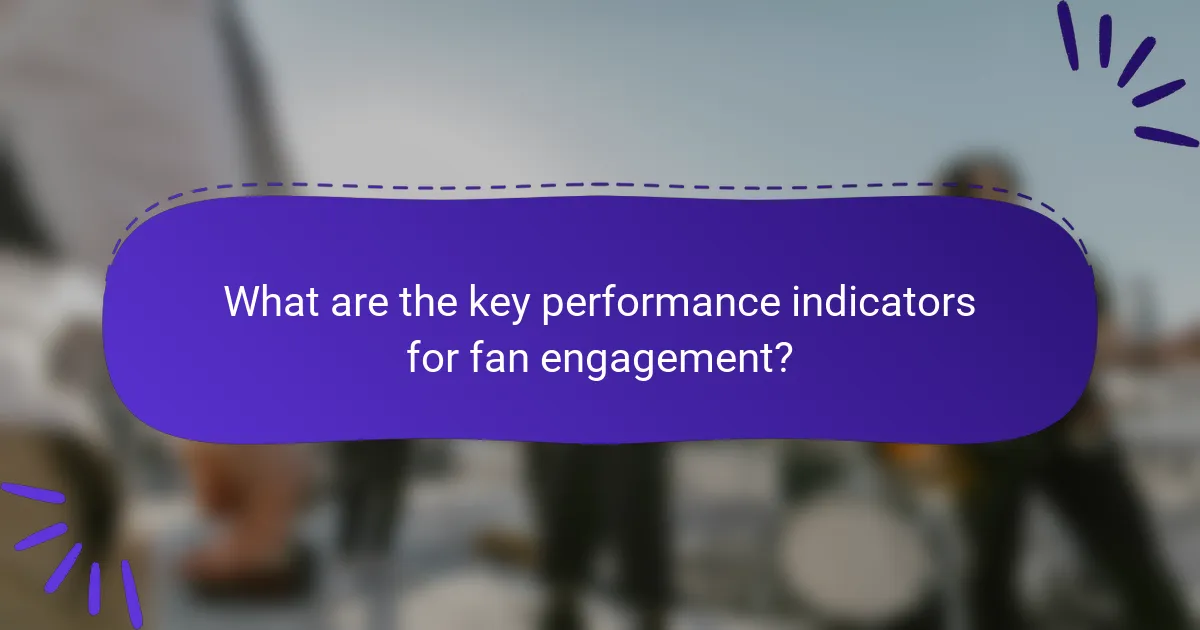Fan engagement campaigns are essential for understanding how audiences interact with a brand and its content. By tracking key metrics such as engagement rates, social media interactions, and event attendance, organizations can gain valuable insights into fan involvement. Employing effective tracking methods enables brands to measure engagement levels and refine their strategies for future campaigns.

How to measure fan engagement in campaigns?
Measuring fan engagement in campaigns involves tracking various metrics that reflect how actively fans interact with your content and brand. Key indicators include engagement rates, conversion metrics, social media interactions, email open rates, and event attendance, each providing insights into different aspects of fan involvement.
Engagement rate
The engagement rate quantifies how many fans interact with your content compared to the total audience. It is typically expressed as a percentage and can include likes, shares, comments, and other interactions across platforms.
To calculate the engagement rate, divide the total interactions by the total followers or reach, then multiply by 100. A healthy engagement rate often falls between 1% to 5%, but this can vary by industry and platform.
Conversion metrics
Conversion metrics track how many fans take a desired action, such as making a purchase or signing up for a newsletter. This metric is crucial for understanding the effectiveness of your campaigns in driving tangible results.
To measure conversions, set clear goals and use tracking tools like Google Analytics to monitor actions taken by fans. A conversion rate of 2% to 5% is generally considered good, but this can depend on the type of campaign and audience.
Social media interactions
Social media interactions encompass all forms of engagement on platforms like Facebook, Twitter, and Instagram. This includes likes, comments, shares, and retweets, which indicate how well your content resonates with fans.
Monitoring these interactions can help you identify which types of content perform best. Aim for consistent growth in interactions, and consider using social media analytics tools to track performance over time.
Email open rates
Email open rates measure the percentage of recipients who open your emails. This metric is vital for assessing the effectiveness of your email marketing campaigns and understanding fan interest.
A typical open rate ranges from 15% to 25%, depending on the industry. To improve open rates, focus on crafting compelling subject lines and segmenting your email list to target specific fan groups.
Event attendance
Event attendance metrics indicate how many fans participate in your events, whether virtual or in-person. This is a direct measure of fan engagement and interest in your brand activities.
To track attendance, compare the number of registrations to actual attendees. A good attendance rate typically falls between 50% to 70% of registered participants, but this can vary based on the type of event and promotional efforts. Consider offering incentives to boost turnout.

What are the key performance indicators for fan engagement?
Key performance indicators (KPIs) for fan engagement measure how effectively a brand connects with its audience. These metrics help assess the success of engagement strategies and guide future campaigns.
Net promoter score
The Net Promoter Score (NPS) gauges fan loyalty by asking how likely they are to recommend a brand to others. Responses are typically categorized into promoters, passives, and detractors, allowing organizations to calculate a score that ranges from -100 to +100.
A high NPS indicates strong fan engagement, while a low score suggests areas for improvement. Regularly tracking NPS can help identify trends and measure the impact of engagement initiatives over time.
Customer lifetime value
Customer Lifetime Value (CLV) estimates the total revenue a fan will generate throughout their relationship with a brand. This metric considers factors like purchase frequency, average transaction value, and retention rates.
To maximize CLV, brands should focus on enhancing fan experiences and fostering loyalty. Strategies may include personalized marketing, exclusive offers, or community-building activities that encourage long-term engagement.
Return on investment
Return on Investment (ROI) measures the profitability of fan engagement campaigns relative to their costs. A positive ROI indicates that the benefits of engagement efforts outweigh the expenses incurred.
To calculate ROI, divide the net profit from engagement activities by the total costs, then multiply by 100 for a percentage. Brands should regularly evaluate ROI to ensure that resources are allocated effectively and to refine their engagement strategies based on performance data.
![]()
Which tracking methods are effective for fan engagement?
Effective tracking methods for fan engagement include a variety of analytical tools and platforms that provide insights into fan behavior and preferences. Utilizing these methods allows organizations to measure engagement levels, identify trends, and refine their strategies accordingly.
Analytics tools like Google Analytics
Google Analytics is a powerful tool for tracking website traffic and user behavior, making it essential for measuring fan engagement. By setting up goals and events, organizations can monitor how fans interact with content, such as video views or merchandise purchases.
To maximize its effectiveness, ensure that you regularly review key metrics like bounce rates, session duration, and conversion rates. This data can help you understand which content resonates most with fans and where improvements are needed.
Social media insights
Social media platforms offer built-in analytics that help track engagement metrics such as likes, shares, comments, and follower growth. These insights are crucial for understanding how fans interact with your brand on platforms like Facebook, Instagram, and Twitter.
Regularly analyze engagement rates and audience demographics to tailor your content strategy. For example, if a particular post format garners significantly more interaction, consider producing similar content to boost overall engagement.
Survey platforms like SurveyMonkey
Survey platforms like SurveyMonkey enable organizations to gather direct feedback from fans regarding their preferences and experiences. This qualitative data can provide valuable insights into what fans enjoy or wish to see improved.
When creating surveys, keep questions concise and focused. Aim for a mix of multiple-choice and open-ended questions to capture both quantitative and qualitative data. Regularly conducting surveys can help track changes in fan sentiment over time, allowing for timely adjustments to engagement strategies.

How to optimize fan engagement campaigns?
To optimize fan engagement campaigns, focus on creating targeted content, personalized communication, and effective incentives. These strategies enhance interaction and loyalty among fans, leading to improved campaign performance.
Targeted content strategies
Targeted content strategies involve tailoring messages and materials to specific segments of your fan base. By analyzing demographics, interests, and behaviors, you can create content that resonates more deeply with different groups.
For example, a sports team might share behind-the-scenes videos with hardcore fans while providing highlights and news updates for casual followers. Using analytics tools can help identify which types of content generate the most engagement.
Personalized communication
Personalized communication enhances fan engagement by making interactions feel more relevant and meaningful. Utilizing data from fan interactions, you can customize emails, messages, and social media posts to address individual preferences and behaviors.
Consider using fans’ names in communications or referencing their past interactions. This approach can significantly increase open rates and responses, fostering a stronger connection between fans and your brand.
Incentives and rewards
Incentives and rewards are crucial for motivating fan participation and loyalty. Offering exclusive access, discounts, or special experiences can encourage fans to engage more actively with your campaigns.
For instance, a loyalty program that provides points for attending events or purchasing merchandise can drive repeat engagement. Ensure that the rewards are appealing and relevant to your audience to maximize their effectiveness.
![]()
What are common challenges in tracking fan engagement?
Tracking fan engagement presents several challenges, including data privacy concerns and attribution difficulties. These issues can complicate the measurement of how effectively campaigns resonate with fans and how to optimize future strategies.
Data privacy concerns
Data privacy is a significant challenge when tracking fan engagement, especially with regulations like GDPR in Europe and CCPA in California. Organizations must ensure they comply with these laws while collecting and analyzing fan data, which can limit the amount of information available for insights.
To navigate these concerns, it’s essential to implement transparent data collection practices. Always inform fans about how their data will be used and obtain their consent. This not only builds trust but also aligns with legal requirements.
Attribution difficulties
Attribution difficulties arise when trying to determine which engagement efforts lead to specific fan actions, such as purchases or event attendance. With multiple channels available, it can be hard to pinpoint the exact source of engagement.
To improve attribution accuracy, consider using multi-touch attribution models that account for all interactions a fan has with your brand. This approach can provide a more comprehensive view of how different channels contribute to overall engagement.

